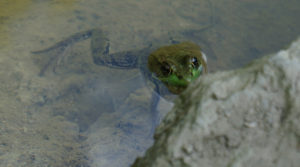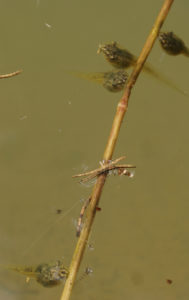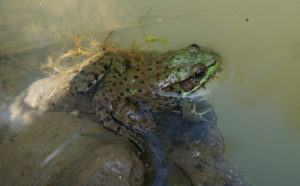Nature Reflections: Green frogs and bluegills
by D.E. Bentley –

A population of green frogs inhabits our pond. These frogs, which come in a range of colors, from green to brown to bronze – with mottling and a bright green upper lip – are found in the eastern half of the US and into southeastern Canada. Green frogs average from 2 to 4 inches long and enjoy sitting at or in water’s edge.
Mating season begins in April or May, a time many people associate with tadpoles, but can continue all summer. The female green frog can be distinguished from the male
by smaller tympanums (ears) that are about the size of their eyes (the males tympanums are larger). The females also lack the yellow throats exhibited by the males. Female frogs produce about 3,000 to 5,000 eggs that they deposit in masses, attached to plants below the water surface. The males then fertilize these eggs.

Green frog tadpoles can be seen all summer, as they take from three months to two years to absorb their tails, grow legs and develop lungs, slowly morphing into full-grown adult frogs. They are a food enjoyed by largemouth bass, which our pond was stocked with earlier this summer (along with blue gills and minnows).
The stocked lower portion of the pond had large numbers of tadpoles earlier in the season, but my recent green frog and tadpole viewing opportunity was in the smaller pond – that feeds into the larger pond, where the bass live. Perhaps some of the frogs from the lower pond realized the benefits of this upper, fish-free pool as a safer place to raise their young.

Inclined to make a squealing noise as they leap into the water when startled, the green frogs became acclimated to me as I worked along the shoreline, providing a photo opportunity. After a bit they almost seemed to be posing for the camera. Further away from the shore the tadpoles swam about or clustered along sticks and other floating debris.
Meanwhile, at the shallow end of the large pond area, spawning season is beginning for the bluegills, small-bodied freshwater fish that range from 6-12 inches long, with flattened bodies. The breeding males – which have a rusty-brown belly in contrast to the yellow bellies of the females – have dug a series of holes in the shallow water. The females have already chosen their mates and joined in their ritualistic mating “dance,” as several of the visible holes are now being guarded by male bluegills. The males remain at the holes for five days, until the eggs hatch and the young are able to swim on their own. The young bluegill feed on microscopic animals, while the bass will feed on exposed young and the green frog tadpole.
We are waiting on the Great Blue heron that will gleefully feed on all.